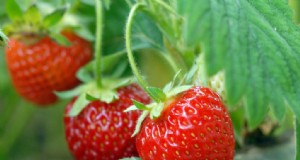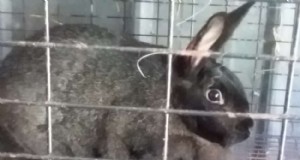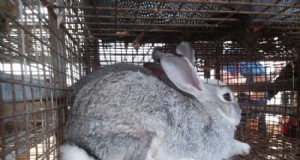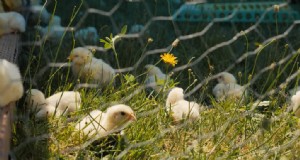食肉用の豚を育てる方法を学ぶことは、より自立したいと考えている農家や農場にとって素晴らしい選択肢です。しかし、品種を選択してケアを調整するには、少しノウハウが必要です.肉用の豚を育てるための12のヒントを読んでください.
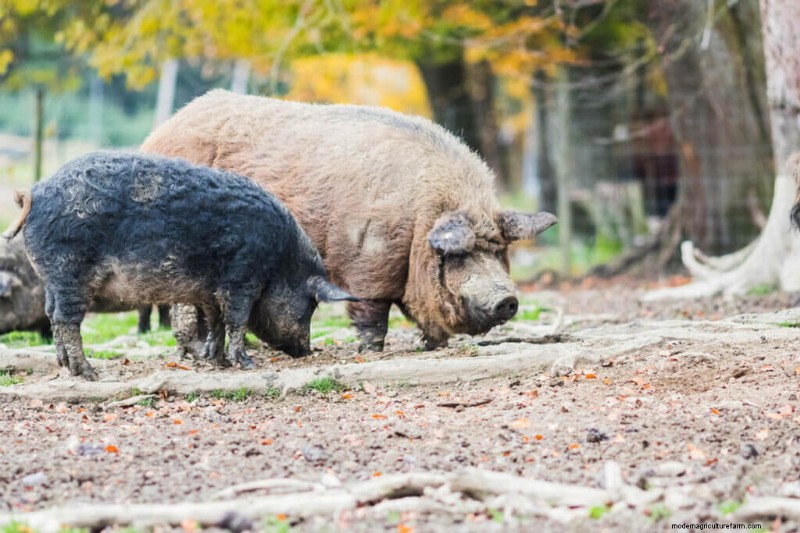
この投稿は、もともと 2015 年にオータム クリーク ランチのエイミーによって書かれ、公開されたもので、その後更新されて、「ポーク」ライン キュアトンとのインタビューが追加され、さらに詳しい情報が得られました。お楽しみください!
以前のポッドキャストで、アメリカン モルモットの育て方について話しました なぜその特定の品種を選んだのか。別のポッドキャストで、ギニアホッグを食肉用に飼育する価値があるかどうかについて話し合いました 、再調達するかどうかも含めて。
今日のポッドキャスト ゲスト (Pioneering Today ポッドキャスト エピソード #331) は "Pork" Rhyne で、幸運にも Homesteader's of America Conference で彼に会うことができました。 .彼がポッドキャストに出演して、豚に関するすべてのことについて話し合うのが待ちきれませんでした!
“Pork” Rhyne は、国際的な農業教育者およびニッチ ミート マーケティングの専門家として働いています。彼は、ビジネスとマーケティングについて、経験豊富な農業従事者と初心者の農業従事者を訓練し、教育することに人生を捧げてきました。 (ポークをオンラインで見つけることができる場所については、この記事の最後までお読みください!)
自分で肉、つまり豚肉を育てる準備ができていない場合は、それがその日のトピックであるため、ブッチャー ボックスをお勧めします。 .
Butcher Box はたまたま Pioneering Today Podcast のスポンサーであり、2022 年 1 月 20 日まで、New Year's Bundle と呼ばれる特別なキャンペーンを開催しています。このバンドルでは、初回登録者のみが最初のボックスで 7 ポンドの肉を無料で入手できます! butcherbox.com/pioneeringtoday にアクセスしてください サインアップしてください!
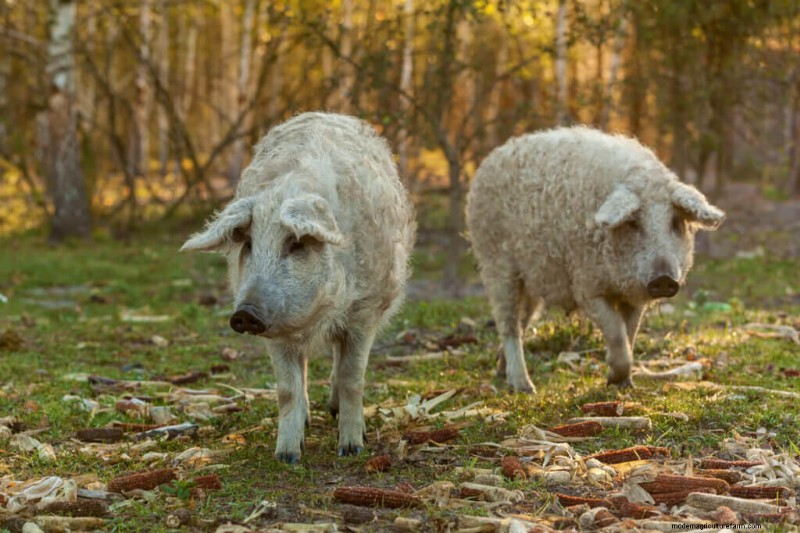
私が豚を飼うのが好きな理由
豚は家庭で育てるのが最も簡単な動物の 1 つだと思います。彼らは肉牛よりもかなり早く成熟し、鶏肉やウサギよりもはるかに多くの肉(およびラード)をレンダリングします(率直に言って、プルドポーク、新鮮なベーコン、家庭でレンダリングされたラード 、塩漬けハム 素晴らしいです!!!)。
飼育するその他の動物
豚の飼育に飛び込む前に、自分で肉を飼育する方法について詳しく知りたい場合は、家畜の計画と 1 年分の食料に十分な肉の飼育に関するこの記事を必ずチェックしてください。 .その他の動物に特化した投稿については、次のとおりです:
- R 裏庭で産卵鶏を育てる
- 裏庭で肉用鳥を育てる
- 乳牛の育て方
- 肉うさぎの飼育
- 羊の飼育(食物繊維用)
- ヤギ飼育ガイド
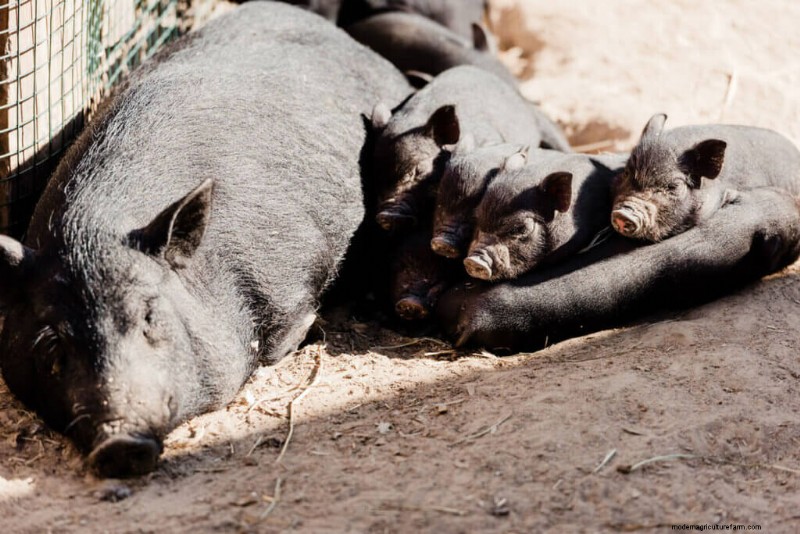
豚を育てるための 12 のヒント
豚を 1 頭 (または 2 頭) 飼うことを考えたことがありますが、どこから始めればよいかわかりませんか?ここでは、おいしい豚肉を自分で育てるためのヒントと指針をいくつかご紹介します。 .
子豚を買う
肉用に年に数頭の豚を飼育することに興味がある人にとっては、自分の種豚を飼育するよりも子豚を購入する方が簡単です.
子豚の価格は、場所、時期 (4 時間齢の子供が見つけようとする春に高くなります)、および品種によって異なります。
この投稿の最初の執筆時点 (2015 年) では、子豚は 1 匹あたり約 125 ドルで販売されていましたが、市場の需要によっては 75 ドルまで安くなる場合もあります。 (現在は価格が高くなっている可能性があります。)
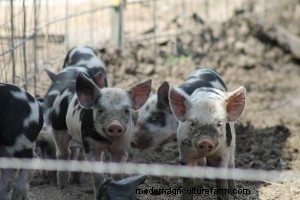
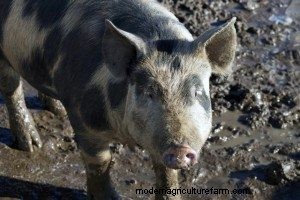
年齢の問題
子豚を販売するための業界標準は生後 6 週間です。ただし、8 週齢の子豚を販売するのは、2 週間余分に母豚と一緒にいることを許可された子豚は、より強い免疫システムを持ち、スターター フィードを与える必要がないことがわかったからです。
もちろん、それは母豚の状態を維持するために追加の餌を与えなければならないことを意味しますが、より健康な子豚にはそれだけの価値があると考えています。
もう少し長く授乳することを許可されている子豚を見つけることができれば、追加費用を支払うだけの価値があります。これにより、飼料代と子豚の潜在的な健康上の懸念の両方を節約できるからです。
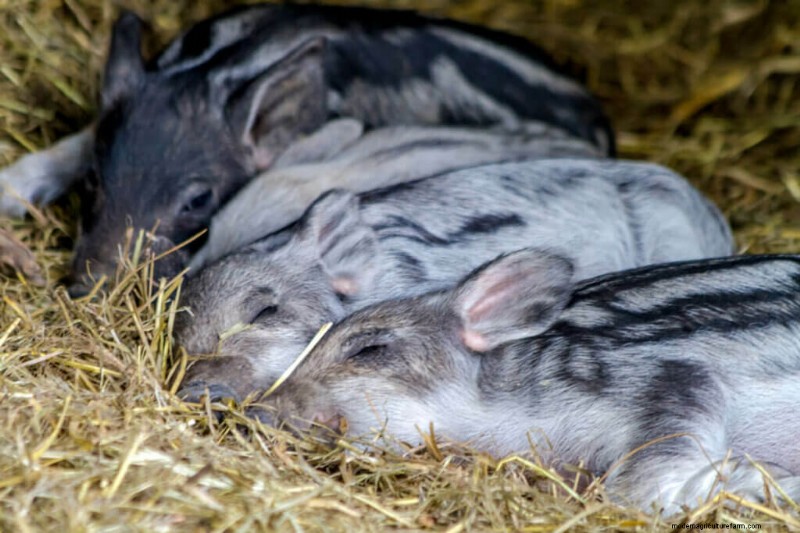
スペースに関する考慮事項
子豚を家に持ち帰る前に、囲いと子豚のためのシェルターを用意する必要があります。フェンシングについては後ほど詳しく説明しますが、ペンを計画する際に考慮すべき考慮事項がいくつかあります。
ペンが小さい場合、子豚は運動するスペースがあまりなく、地面が本当に破壊される可能性があるため、子豚はより速く成長します.
また、狭い範囲では、寄生虫が成長する可能性が高くなります。最後に、天候が湿っている春の小さなペンは、非常に大きな泥の穴になる可能性があります.
ただし、Pork Rhyne がポッドキャストのインタビューで説明しているように、豚を放し飼いにしたり放牧したりするためのスペースが必要というわけではありません。自分の豚を育てることは、たとえその豚にとって理想的な生活条件を持っていなくても、商業的に育てられた豚肉製品を購入することよりも大きな一歩です.
私たちは、暖かい季節には回転エリアを使用し、寒い季節には家に近い非常に広いエリアを使用することを好みます (実際、冬の間は庭に豚を置いて、春の植え付けに備えて豚を耕して肥料を与えることができるようにします)。
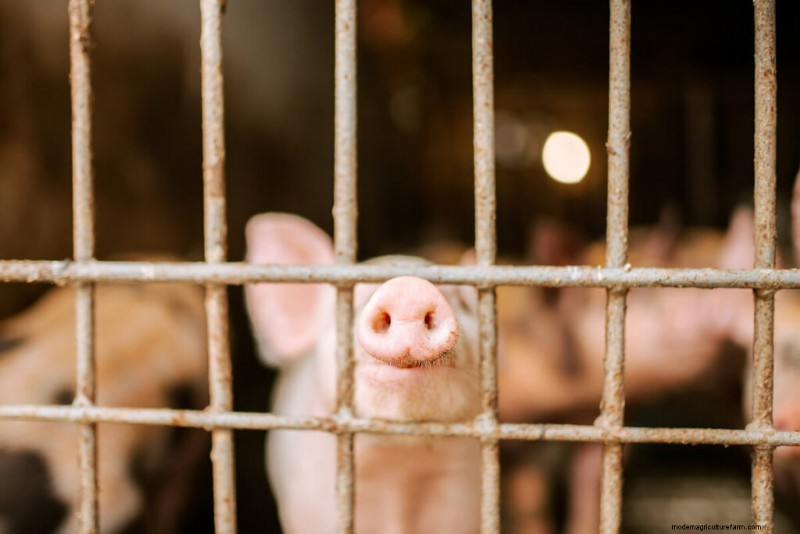
フェンシング
子豚が若いときは、牛のパネル、豚のパネル、またはパレットペンにいる方がよい.
電気ネット、ひも、またはワイヤーは、小さな子豚が外に出る可能性があるため、うまく機能しません(多くの経験と、私たちの財産の周囲の森で2週間離陸した子豚から話されました)。
子豚は、12~15週齢になるまで底に電線が張られた小さなパネル囲いに入れられ、その後、屠殺可能な体重になるまで、電気紐またはワイヤーで作られた囲いに移されます。
通常、12 ~ 15 週間で彼らは電気の訓練を受け、電気を使いこなせないほど大きくなります。ただし、電気ではない出口やゲートがあるのは良いことです。豚は電気柵に慣れているため、豚を移動させたいときに、電気柵があった場所には近づきません。
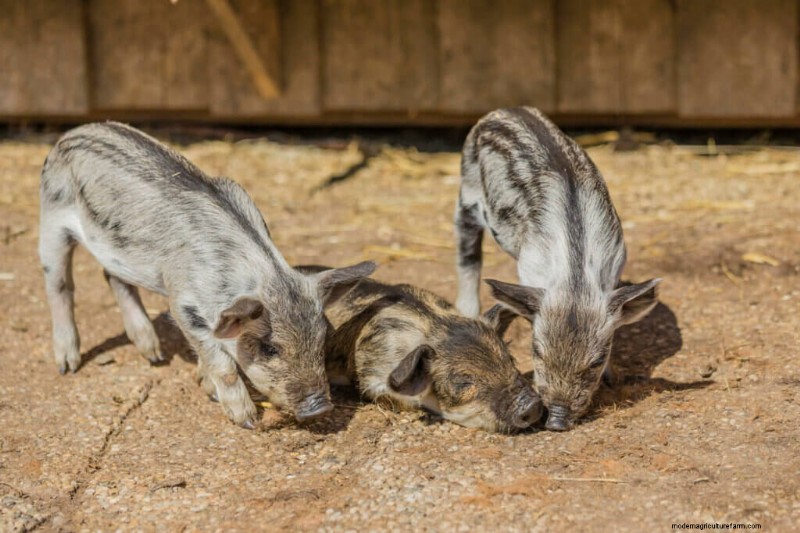
豚に餌をやる
豚に餌をやる方法はたくさんあります。最も簡単な方法は、商業養豚業者を購入することです。豚はこの種の飼料で最も速く成長します。残念ながら、ほとんどの商業養豚場の処方には、GMOである可能性が高いトウモロコシと大豆が含まれています.
多くの市販の飼料には、特定の動物に必要な場合とそうでない場合がある医薬品も含まれています.
私たちは動物に不必要に薬を与えるのは好きではないので、別の選択肢として、穀物やタンパク質源から独自の飼料を作るか、お住まいの地域で天然の既成飼料を見つけることです.
Pork Rhyne が豚に餌を与えることについて言わなければならないことは次のとおりです。豚に何を与えるかについては、地元のパン屋に行って豚に 1 日前のパンを与えることから、最高のオーガニックの非 GMO 飼料のみを購入することまで、非常に多くの論争があります。 /P>
豚を飼い始めたばかりで、健康な豚の姿を知らない人がたくさんいます。そこで彼は、豚を飼っている他の人と一緒に時間を過ごして、豚が食べる量、季節によって食欲がどのように変化するか、健康な豚とはどのようなものかを学び、順応することを勧めています.
私たち入植者は、代替ルートが大好きです。DIY ができるときや、何かを行うための別の方法があるときはいつでも、それに飛びつきます!それは私たちの本質だと思います。しかし、独自の豚用飼料の作成に飛び込む前に、肉屋に行くときに満足のいく脂肪と肉の比率の製品を得るために、飼料の成分を理解し、豚に与える方法を知ることが重要です. /P>
- 炭水化物 – エネルギー源、多くの場合トウモロコシまたは穀物
- タンパク質源 – 大豆、さやいんげんなど
- 繊維/鉱物/その他 – これらは、豚の健康を維持するための残りの飼料となります
飼料の基本的な成分が揃ったら、品種ごとに炭水化物とタンパク質のニーズが異なるため、特定の品種について知ることも重要です.
アメリカン ギニア ホッグに関しては、肥満になりやすいため、豚に脂肪がつきすぎないように炭水化物を減らす必要があります。
Pork Rhyne には、豚を屠殺した後に得た肉と脂肪の比率に本当に失望した友人がいましたが、屠殺前にタンパク質を減らすのではなく、生涯を通じて豚に 16% の粗タンパク質を与えていたことが判明しました。 .
通常、屠殺の約 2 ~ 3 か月前に、ポーク ラインはタンパク質の量を 12 ~ 14% に減らし、炭水化物の量を増やしてそのエネルギーを脂肪に変えることを推奨しています。
上で述べたように、これはすべて品種間で異なり、ヘレフォード、伝統品種、商用品種などでも異なります.
既製の飼料に加えて、豚はあらゆる種類の農産物が大好きです。マンゲル、飼料用カブ、ビーツ、カボチャなど、豚専用の作物を育てることもできます。
私たちの農場では、地元産の大麦とエンドウ豆に豚のミネラルを加えたものを与えています。私たちの豚はまた、たくさんの新鮮な牛乳、テーブルのスクラップ、地元のリンゴやカボチャを手に入れます.
豚にベーカリーのスクラップなどを与えないでください。豚は健康で、おいしい肉が食べられると期待してください。豚が食べるものを食べるので、品質が重要です。
豚に餌をやる方法のもう 1 つの例は、Pork Rhyne の友人が Chipotle (ファストフード レストラン チェーン) に行って、豚に餌をやるために消費者に販売されていない豆を拾ってきたことです。
私はすべて機知に富んでいます!あなたが手に入れている食品が消費者のものではないことを確認してください(つまり、最初に顧客に提供された後、豚に病気を広めるためにゴミ箱に捨てられませんでした)、製品に豚肉が含まれていないことを確認してください.
私が好きなことの 1 つは、フィードをできるだけローカルに調達することです。約 1 時間離れた場所に非 GMO スタンスの穀物倉庫があり、穀物も可能な限り地元で調達しようとしています。地元の食料庫から購入する際の節約のヒントについては、動物用飼料の買いだめ (+ 動物に与える量) をご覧ください。
また、豚に使用済み穀物(ビール醸造所から得られる醸造穀物など)を与えている場合、その約80%が水です.たとえば、その穀物が乾燥している場合、約 29% のタンパク質が含まれますが、穀物が湿っている (または消費されている) と、7.7% の粗タンパク質しか含まれません.
使用済み穀物も非常にすぐにカビが生えるので、Pork Rhyne はこれを主な供給源ではなく食事への追加として推奨しています.
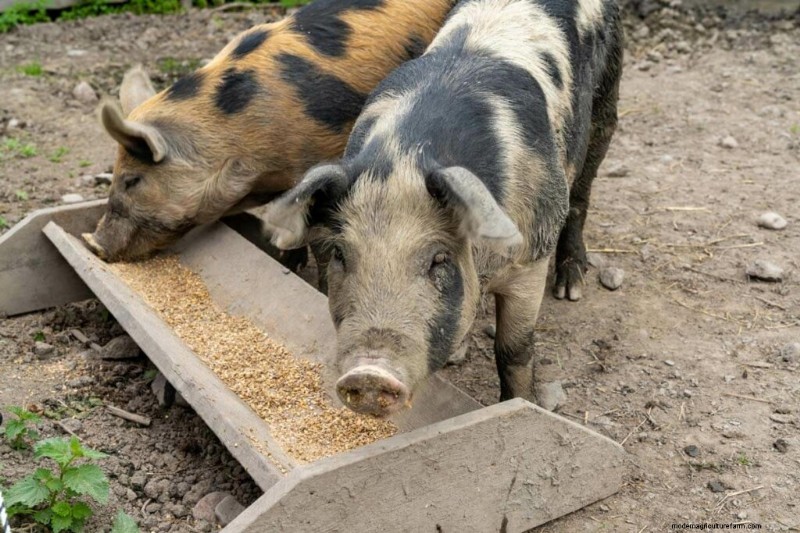
需要対測定給餌
豚を飼育する際に考慮すべきもう 1 つのことは、セルフフィーダーを設置して豚がいつでも食べられるようにするか、毎日決まった量の餌を与えるかです。
どちらにも長所と短所があります。デマンド給餌により、豚の給餌器を満たす必要がある日を除いて、毎日の作業負荷が小さくなります。また、豚が常にエサを利用できるようにすると、根が張る可能性が低くなり、地面がより良い状態に保たれます。需要に応じて飼育されている豚は、成長が早い傾向があるため、成熟するまでの時間が短くなります。
需要給餌の問題点は、豚が大量の餌を食べることができ、特に豚が年をとるにつれて、これが高価になる可能性があることです.
1 頭か 2 頭の豚を飼育している場合は、給餌が最適であることがわかりました。 10 枚以上上げると、法外なコストになる可能性があります。
私たちは、子豚のそれぞれに、毎日5ポンドの穀物混合物を与えています.これに加えて、彼らは牛乳、食卓のくず、農産物を手に入れます。
これにより、約 8 か月齢で市場体重の豚を飼うことができます。
薬と駆虫 (DIY 駆虫)
私は化学駆虫剤のファンではありません。なぜなら、それらが作成する突然変異と耐性のためです.
私たちの農場では、とにかくニンニクがはるかに効果的な駆虫剤であることを発見しました.
1トンの飼料に約1ポンドのニンニク顆粒を加えます.
さらに、オレガノオイルは、寄生虫や感染症との戦いにも優れています.
最後に、出血にはゼラニウム エッセンシャル オイルを、切り傷や擦り傷にはティー ツリー オイルを常備しています。
去勢するか否か
豚の去勢は物議を醸す問題です。この慣行は残酷で不必要だと考える人はたくさんいますが、イノシシの汚染を防ぐために行う必要があると言う人もいます.
雄豚を 2 頭飼育している場合は、この手順を実行するかどうかを決定する必要があります。
ただし、異性の子豚を飼育している場合は、去勢するのが賢明です。私たちが最初に子豚を飼い始めたとき、子豚は生後9か月になるまで繁殖を開始しないと言われました.私たちは生後 8 か月で屠殺したので、去勢する必要はないと考えていました。
悪いアドバイスで、妊娠中の市場の豚になってしまいました。現在、肉用に飼育されたすべてのオスの子豚を去勢しています。 バッハのレスキュー レメディを見つけました このプロセスで非常に役立ちます – 豚と去勢を行う人の両方を落ち着かせます.
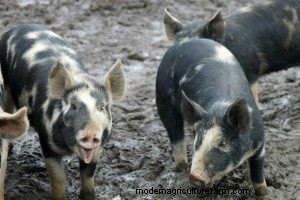
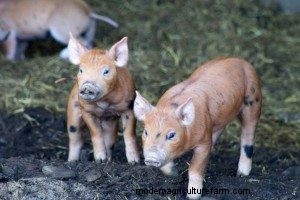
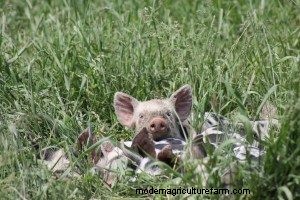
品種は重要
豚は品種によって、大きさ、肉質、気質などの違いがあります。
これらは、家に持ち帰る前に子豚を選ぶときに調査したいものです.
従順でフレンドリーな気質と肉質の良さから、伝統的な品種の豚 (グロスター オールド スポット、アメリカン ギニア ホッグ、タムワース) を飼育しています。
アメリカン モルモットは豚の中でもかなり小さい品種であり、従来の枝肉の重量にはなりませんが、取り扱いが容易でシェフ品質の肉であるため、喜んでトレードオフを行います。
Pork Rhyne の最初の豚は、実際には「ラージ ブラック」と「レッド ウォブル」と呼ばれる伝統的な品種でした。彼はまた、いくつかの交配種や商業用の豚を育てました。
200 年前の豚は、現在のように餌を与えられていませんでした。彼らはニワトリと同じように、キッチンや庭からスクラップを与えられたり、放し飼いで反芻したりなど、低インプットの動物でした.
長年、豚は「フェイルセーフ」でした。ある年に作物が不作だった場合、家族は常に生計を立てるために豚を売っていました。
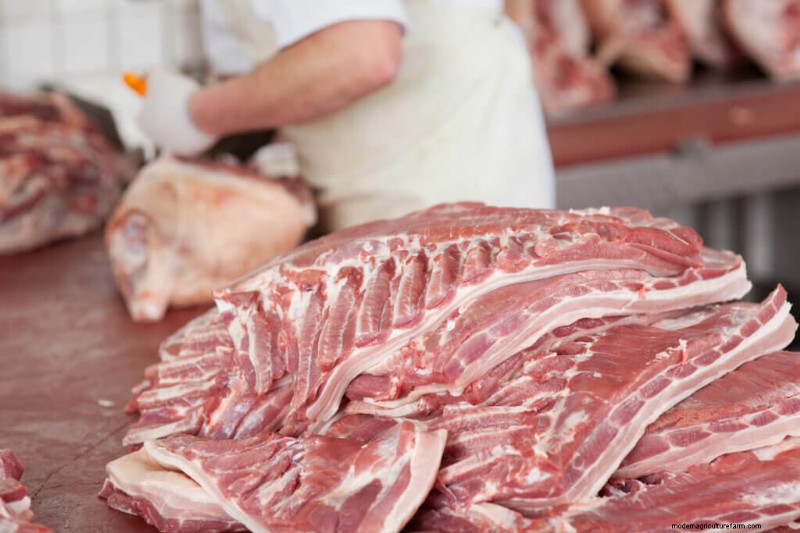
ブッチャーウェイトとハンギングウェイト
ほとんどの伝統的な豚は、体重が約 180 ~ 250 ポンドになると屠殺されます。これにより、吊り下げ重量 (肉と骨から頭、足、内臓を差し引いたもの) が 160 ~ 225 ポンドになります。
冷凍庫にどれだけの肉が残るかは、加工中に選択したカットの種類に完全に依存します.
伝統品種の豚は市販の豚よりも成長が遅いことを理解することが重要です。
通常、遺産の品種は、約280ポンドに達するまでに約8か月かかります.ラード豚は、屠殺できる体重に達するまでに 1 年から 1 年半かかります (品種によっては、それほど重くない場合もあります)。
しかし、商用豚はわずか 6 か月で 280 ~ 300 ポンドに達します。これで、商用豚が大規模農場でより人気になった理由がわかります。
個々の品種に関するより正確な情報については、Livestock Conservancy Organization からこの表をダウンロードしてください。 .
品種を選択する前に、何のために豚肉を育てたいかを理解してください。多くの品種は、ブラートヴルスト、ソーセージ、豚肉などに適していますが、他の品種はハム、ポーク チョップ、大きなローストに適しています。
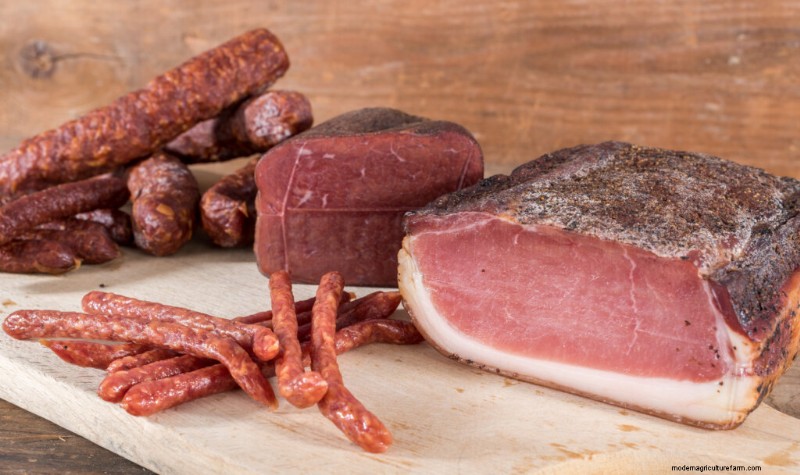
肉屋を雇うべきですか?
私たちは農場で多くの豚を屠殺してきました。慣れてしまえばそれほど難しくはありませんが、初めての場合は少し戸惑うかもしれません。
全体のプロセスには約 3 日かかります。 1日目は屠殺と吊るし、2日目は皮を剥いて切り刻み、3日目は通常ソーセージの加工です。
自分を屠殺することのマイナス面は、ベーコンとハムを治す方法を知らないことです。 あなたはそれらのカットで終わることはありません(あなたは本当に良い生ハムを持っていますが、伝統的な生ハムとは異なります).
自分自身を屠殺する利点は、ノウハウとコスト削減です。伝統的に、豚の屠殺には、処理と養生に応じて 150 ドルから 250 ドルの費用がかかります。
味は最高です
自分の豚を育てることで、豚が食べるものをコントロールし、家族にとってより健康的な製品を作ることができます.
また、豚を飼うのはとても楽しいです。しかし、豚肉を育てる一番の理由は、味だと思います。一度食べたら、スーパーの豚肉はもう食べたくなくなります。
エイミーの詳細

エイミーは妻であり、18 人の子供の母親です。大家族の子育てとホームスクーリングに加えて、彼らは小さな家族経営の農場も経営しており、愛情を込めて「オータム クリーク ランチ」と呼んでいます。 」彼らは Joel Salatin (私も!) の仕事が大好きで、彼の模範によって彼らの行動の多くをパターン化しています.
豚の飼育について質問です。 [email protected] で Amy に電子メールを送信できます
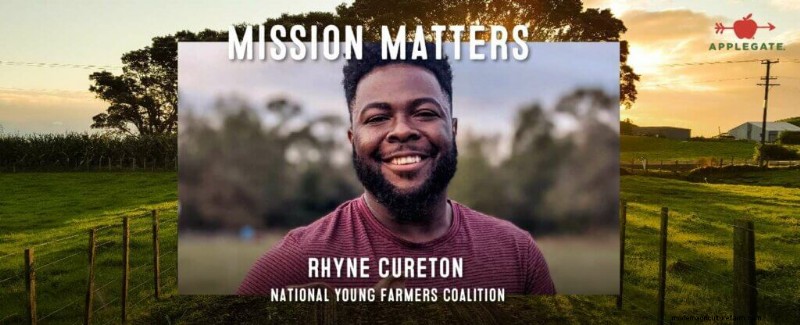
「ポーク」ライン・キュルトンの詳細
ポッドキャスト (41 分から開始) を必ず聞いて、EATBETA という会社を通じて第三世界の国々でポーク ラインの活動について聞いてください。
トランスクリプトメールダウンロード新しいタブ
メリッサ・K・ノリス: パイオニアの皆さん。 Pioneering Today ポッドキャストのエピソード番号 331 へようこそ ... 今日は、私のお気に入りのトピックの 1 つについて話します。それらはすべて私のお気に入りのように感じますが、これは間違いなくそこにあり、それは豚を育てることです。以前、ポッドキャストのさまざまなエピソードで豚の飼育について取り上げました。私たちはヘリテージ・アメリカン・ギニア・ホッグの知られている品種について話しました...あなたはそれらを見ることができませんが、私は引用符を使用しています.一種の別名、「ホームステッドダーの豚」.私の経験は、ショーノートで、以前のエピソードのいくつかをチェックしたい場合は、それらにリンクします.
今日のエピソードでは、豚に飛び込むことになるので、私は本当に興奮していますが、豚を育てることに関して、特に飼料について、多くの一般的な、またはよく見られるアドバイスについて話します。豚に何を食べさせているか、牧草地の管理、およびそのような他のいくつかのことは、しばしば不正確であるか、必ずしも豚と農家に最高のサービスを提供しているとは限りません.今日のエピソードは、今日のゲストと一緒に飛び込みます。私は本当に興奮しています。インタビューが始まるとすぐに、私がどのように彼らに会ったか、ちょっとしたバックストーリーを聞くことができます.彼を紹介するときは、音量を上げすぎないでください。それは最初のわずか1分間だけです。私がそう言う理由は、あなたがそこに着いたときにわかるでしょう。それはすべて非常に楽しいものであり、実際にそれとトピックに対する彼の熱意を本当に楽しんでいただけると思います.
私がそこに着く前に、今日のエピソードは肉について話しているので、ButcherBox が後援しています。まだ農場での生活を始めていない場合、または肉を購入できる地元の農家を持っていない場合でも、ブッチャーボックスは信頼できる高品質で人道的に育てられた肉を簡単に手に入れることができます.彼らは、100% 牧草で飼育され、牧草で仕上げられた牛肉、放し飼いのオーガニック チキン、伝統的に育てられた豚肉、天然の魚介類を直接あなたのドアに届けます。上記のすべてを実際にサンプリングしました。一日の終わり、そして配達ドライバーのために私たちが乗っている田舎のルートの最後にあったときでさえ、それは常に来て完全に凍っていました.気に入らないものはありませんでした。品質、風味、調理方法に非常に感銘を受けました。上記のすべて、自分で上げられるものでない場合。
素晴らしいことの 1 つは、Pioneering Today ポッドキャストのリスナーであるため、1 月 20 日まで特別なイベントが開催されることです。お正月バンドルです。 ButcherBox に新規顧客としてサインアップすると、最初のボックスで 7 ポンドのミートを無料で受け取ることができます。それを手に入れるには、ButcherBox.com/PioneeringToday にアクセスしてください。それが ButcherBox.com/PioneeringToday です。最初のボックスで 7 ポンドの肉を無料で手に入れましょう。パイオニア トゥデイ ポッドキャストのスポンサーになってくれてありがとう、ButcherBox。
あなたがポッドキャストの新しいリスナーなら、ようこそ。長年のリスナー、ハイタッチ。おかえりなさい、友よ。私の名前はメリッサ・K・ノリスです。私は 5 世代目の農園主です。どこにいても、毎月何千人もの人々が、シンプルでモダンな農園を使用して自家製の手作りの生活を送る方法を学ぶのを手伝っています。本日のゲストはポーク・ライン。本名はライン・キュアトン。おっしゃる通りだと思います。彼は全国の豚肉伝道者として知られており、海外では東アフリカでも知られています。とても興味深く魅力的だと思います。彼は、国際的な農業教育者およびニッチな食肉マーケティングの専門家として働いています。 Rhyne は 5 年以上にわたり、主に小規模な家畜生産、ビジネス、およびマーケティングについて、経験豊富な農業従事者と初心者の農業従事者のトレーニングと教育に人生を捧げてきました。私たちは間違いなく、小規模な家畜農場環境での豚肉の飼育について話し合う予定です。そのため、彼をポッドキャストに迎え入れ、これについて話すことができることを本当に、本当に楽しみにしています.
私が言及した以前のエピソードのいくつかへのリンクを取得するには、MelissaKNorris.com/331 でそれらすべてを取得できます。これはエピソード 331 であるため、331 という数字です。繰り返しますが、MelissaKNorris.com/331。今日のエピソードに行きましょう。
さて、私はこのエピソードにとても興奮しています。皆さんに警告します。私が出会うエネルギーレベルが高い人はほとんどいないので、それは高エネルギーになるでしょう. Pork Rhyne さん、Pioneering Today ポッドキャストへようこそ。
「ポーク」ライン・キュアトン: 私は興奮しています。私は興奮しています。あなたは間違った人をここに連れてきました。
メリッサ・K・ノリス: 間違ったことは考えていません。ちゃんと考えています。 HOAの皆さんのエネルギーが大好きだったので、本当に嬉しかったです。私たちは録音を始める前に少しおしゃべりをしていました.私は基本的に彼にポッドキャストへの招待状を送りました.私は基本的に「ねえ、あなたがカミングアウトしたい日時はいつですか?」と言いました。彼が私の強い武装した招待を受け入れてくれたことを本当に嬉しく思います。私は本当に興奮しています。このエピソードでは多くのことを取り上げることになると思うので、すぐに詳しく説明します。
私たちがチャットしていたときのことの1つは、本当に[inaudible 00:06:06].オンラインで提供されているものがたくさんあるとおっしゃいました。私は、すべての人について最善を尽くすのが好きなので、このようなものの多くは善意で提供されていると仮定しますが、オンラインで豚を飼育することに関しては、多くのことを目にします。 、問題を引き起こすか、問題になる可能性があります。もう少し掘り下げていただければ幸いです。
「ポーク」ライン・キュアトン: そうそう。そうそう。これに入りましょう。私についての背景。農業をしていました。農業に戻ります。 Pork Checkoff で National Pork Board と協力しました。私が農業をしていたときに育てられた伝統的な品種。伝統的な品種に戻ります。私は過去5年間、国内だけでなく海外でも豚の飼育方法を人々に教えてきました.これについて話すとき、私はその経験を利用しています.
養豚業を始めようとしている人たちに気づいたことの 1 つは、彼らはこれまで一度も豚を飼育したことがなく、ほとんどの場合、養豚のバックグラウンドを持っていない可能性が高いことです。飼料、土地の慣行、動物福祉の観点から問題があり、養殖グループ、豚肉産業の従来の基準とモデルに代わるグループに参入するとき、あえて合法主義と言えます。豚に与えるべき餌の量に関して、多くの誤った情報を見てきました。
ちょっと、あなた。メリッサ、相反する情報がたくさんあります。正直なところ、それは人を夢中にさせるはずです。豚の飼育を始めたばかりで、どこから始めればよいかわからない、または 1 つのブログ投稿にアクセスしてから、いくつかの YouTube ビデオにアクセスする人々に同情します。彼らはまったく異なる情報を得ています。一貫性や継続性は本当にありません。ほとんどの人は、「私が使用して成功できる公式は何ですか?」のような公式を探しています。私が払拭したい 1 つの神話、私が今まで見た中で最大の神話の 1 つである豚洗いは、これには公式がないということです。
メリッサ・K・ノリス: アーメン。アーメン。
「ポーク」ライン・キュアトン: 公式は絶対にありません。さて、商業的な従来型農業を始めると、実際には公式があります.それに従えば、うまくいきます。伝統的な品種、屋外、牧草地、納屋で豚を飼育している人々にとって、それは大きく異なります. Aさん、豚が食べる量に影響を与える要素を持っているので、その一貫性はありません.たとえば、暑いとき、豚は暑いときに食べるのが好きではありません。彼らはそうしません。彼らは少しもしません。その後、彼らはあまり食べていないため、筋肉量と脂肪を獲得する能力が低下します.右?寒いときは、暖かく過ごすために熱を発生させる方法として、穀物やあなたが与えているものを使おうとしているので、彼らははるかに多く食べます.実験用ラット環境で豚を飼育していないため、一貫性はまったくありません.私たちはそうではありません。
私が本当に推進していることの 1 つは、農家の視点を持つことです。私が言いたいのは、動物に餌をやったり、水や避難所を与えたりすることだけではありません。それらだけでなく、その間のすべてのコンテンツ。右?本当に必要なのは観察力です。あなたは間違いを犯すでしょう。ええと、メリッサ、あなたではなく、聴衆です。 [クロストーク 00:09:44]
メリッサ・K・ノリス: 大野。私はたくさんの間違いを犯しますが、ありがとうございます。
「ポーク」ライン・キュアトン: バスの下に投げ込まないように努めています...農業を始めたばかりの場合、飼料、住宅、動物福祉の面で多くの間違いを犯すことになります。それでいいです。そこには多くの相反する情報があり、ビデオやブログを書いている多くの人々は、必ずしも私が持っているバックグラウンド、または従来の養豚業者が持っているバックグラウンドを持っていません.多くの人が、今始めたばかりの人から学んでいます。豚を飼って1年以内の方から豚の育て方を学んでいる方もたくさんいます。右?豚を飼育している人々、そして屋外でさえ、数年、5 年、10 年、20 年もの間、彼らはオンラインではありません。多くの場合、これは問題になる可能性があります。
私が言いたいことの1つは、あなたが始めて何かを理解しているとき、自分自身に優雅さを持っているということです.公式は存在しないこと、そしてその公式は品種によって、また豚の特定の種類によって変わることを理解してください.同じ品種でも、サイズのバリエーションはさまざまです。メリッサ、あなたはアメリカン モルモットを飼っていますね。大きな [inaudible 00:11:01] 乗っているものもあれば、非常に小さく作られたものもあります。成長の違いは、1 つの品種内の 2 つの異なるタイプの間で非常に劇的になる可能性があります。繁殖豚には多くのニュアンスがあります。
最終的に Pork Rhyne TV を開始した私の一部は、特定のコンテキスト内で豚の飼育に成功できることを人々に理解してもらうことができます。重要なことは、柔軟であること、建設的な批判を受けることができること、そして観察力を持ち、その観察力をより良い実践に生かすことができることです。残念ながら合法主義に陥ってしまう人をたくさん見てきました。彼らは、「この人はこのように豚を飼っているのだから、あなたがこのように豚を飼っていないなら、あなたは良い農家ではない」と言っています。私はそれをよく聞きます。 「牧草地で豚を育てていないのなら、良い農家ではない」というような人がたくさんいます。まあ、ほぼすべての人が豚を飼うことができると信じています。豚の牧草生産が唯一の方法だとは思いません。そうですか?
メリッサ・K・ノリス: そうですね。
「ポーク」ライン・キュアトン: 私はアフリカに行ったことがあります。彼らは大草原を持っています。彼らはサバンナを持っています。彼らは牧草地を持っていません。彼らが牧草地を持っている場合、彼らは豚を飼っていません。彼らは牛を入れています。彼らは山羊を置いていて、そこに羊を置いています。豚は彼らが放牧する最後のものです。それはまったく意味がありません。また、彼らには2本の足の捕食者がいます。右?四つ足の野生動物だけではありません。彼らは、実際に来て豚を盗む2本の足の捕食者、別名人間を持っています.毎日、または 1 日に数回停電がある場合、電気ネットはありません。右?私は見るのが好きです、文脈は何ですか?あなたの限られたリソースは何ですか?あなたは何を持っていますか?あなたの経験は何ですか?これを行うのにどれくらいの時間が必要ですか?
次に、私が農家と仕事をしているときは、与えられた制限、与えられた時間管理、与えられたライフスタイル、そして適切な動物福祉を可能にする方法の中で、彼らが独自の計画を立てるのを手伝っています.私たちの特定のホームステッドと農業の分野では、非常に合法的な人々がいて、商業農場を本当にバッシングすることになります.それから私が目にする問題は、私がこれらの自作農場に行くときです. I see animals in more deplorable situations than when I see when I go into a commercial hog situation, or even when I see when I go to East Africa. Explain that to me. How can one person be bashing and sense some, yet not have proper animal welfare? That makes absolutely no sense, but this is something that I see a lot in common with people who want to have a formula for how they be successful, or want to be in legalism on there's only one way of doing something right. I truly don't believe that. I think there are multiple ways of having healthy hogs, and even a healthy family with those hogs.
Melissa K Norris: うん。 I completely agree with you on so many things, especially with the context in looking with where you at and working within the resources, and also understanding climate, as well as workload. Until very recently, actually, I worked a day job where I was commuting. I was a pharmacy tech and was commuting 18 miles one way. My husband still works off of our homestead and farm, so he still has a day job. For us, we do have our pigs on pasture, but we don't rotate them. They're not on fresh grass every day, simply because when you leave at 5:00 AM in the morning, and it's dark, and you're not getting home until sometimes 6:00 at night, if not later, there's only so many hours in the day. I think, just like you said, that that legalistic part ... Yes, no matter what method you choose to raise your pigs, you're going to want to make sure that you are raising them as ethically and as humanely as possible, but there's more than one way to do that.
I'm really happy that you're talking about that, and also looking at your climate, because, from our experience, the American Guinea Hogs that we had, it overall was a very pleasant experience that I have. Were They Worth It?: a different episode you guys can all go and listen to on that in drawing the difference between raising the Hereford versus the American Guinea Hogs. You really need to dig into your climate with the different breeds, as well as expectations.
I wanted to circle back to one of the things, and that is feed. Feed, not only how much, as you said, and definitely your climate, and the time of year, and so many things we're going to determine. The best thing is looking at the animal. Does it look healthy? Does it look underweight? Is it looking too fat, and [inaudible 00:15:45] ... but types of feed, because, as you know, that is also controversial. Who knew homesteading could be so controversial? I swear, every aspect of homesteading I talk about, there's controversy somewhere or another. I'd love to address that, because I know this is a thing where some people are like, "Well, just go. Go to the bakery and get day old bread that they're getting rid of." Then you've got your purists.右? There's all these things. Let's talk about them. Why is that a good idea? Why is that not a good idea? All the things. Let's dive into feeding pigs.
"Pork" Rhyne Cureton: Oh, man. You mentioned earlier of what does a healthy a pig look like? I think part of the issue is a lot of people who are starting raising pigs doesn't know what a healthy pig looks like.
Melissa K Norris: Yeah.
"Pork" Rhyne Cureton: Or how a healthy pig behaves, so that's part of the reason why I'd say, before you get your pigs, spend some time volunteering on a local farm that has the practices that you want to have, if possible. That's not for everybody. Not everyone has the time or energy. Even if it's just like, "You know what? I'm just going to spend a weekend once a month going to a farm. They might be a couple of miles away, several miles away, but I want to learn how they're doing things and get acclimated," because when you're starting out with no understanding of a strong foundation of what a good animal looks like, of what good proper feed management looks like, then you're just shooting in the dark hoping that you hit something. Sometimes that might be at the detriment of your hogs. I've heard plenty of stories. Pigs die. Let me tell you something. It's hard to kill pigs. You have to really try hard to kill pigs, but I've heard plenty of stories of homesteaders that had mismanaged their pigs so poorly that they end up passing away.
Melissa K Norris: Wow.
"Pork" Rhyne Cureton: That's extraordinarily unfortunate. That's why I say get under somebody who knows what they're talking about, not just these people on YouTube or on the blog posts, but someone who's got five years of experience, even three years of experience raising pigs, and can give you a little bit of advice and guidance. If we're starting to talk about feed, one thing, at the HOA conference, I did a whole thing about alternative feed, because I know that's what homesteaders love to talk about. They love to talk about how they're getting alternative this and alternative that, and saving money here and there. Oftentimes I've seen pigs who are emaciated, or pigs who are obese, pigs who have carcass qualities that aren't what the homesteader intended them to have. Right?
Melissa K Norris: Mm-hmm (affirmative).
"Pork" Rhyne Cureton: If you're expecting the meaty hog but you're feeding it nothing but carbohydrates, when it's time to process it, all you're getting is a really fat, obese pig. You're getting more lard than you probably know what to do with. Now, with homesteaders it's not as much of a problem, because a lot of homesteaders like to use lard.
Melissa K Norris: Amen.
"Pork" Rhyne Cureton: アーメン。 Thank the lard. Praise the lard.
Melissa K Norris: はい。 Yep.
"Pork" Rhyne Cureton: Praise the lard. Praise the lard. Hallelujah ... A lot of times it's like, "Oh, but I wanted more weeks. Oh, but my bacon, it's 90% fat and 2% actual muscle meat. Why is that?" I think the biggest thing is understanding what is feed? What are the components of feed? At the conference, I talked about how very simply, and I teach this in East Africa where I'm not speaking their language. I have to have a translator to do that, so I have to speak very simply. What I normally will say is feed is made out of carbohydrates. Examples of carbohydrates using feed, would be things like corn.右? Energy source.右? Think of carbs as energy sources. Then you have your protein source. Oftentimes a conventional feed will use soybeans as a protein source.右? Then you're thinking about fiber, minerals, other different aspects about feed that really go a long way in terms of having a healthy quality hog.
I can say, "Oh, well, just feed 16% protein, for protein feed, that's already been milled, and feed that to your pigs." Well, that's not completely accurate because, for American Guinea Hogs, they're so obesity prone that they really need to be on an extraordinarily limited grain diet.右? More opportunity for forage, so don't feed them a whole bunch of bread if you have lardy based pigs, unless you want a lot of fat and not a lot of meat. If that's what you want, perfect.罰金。あなたは素晴らしい仕事をしています。 If you're wanting more meat on your hog, but you're raising heritage, more lardier breeds, then you want to be really consistent and conscious about how much carbohydrates they're eating.
Let's say you have a meatier pig, like I would at Jason at [inaudible 00:20:44]. We had butchered a hog, and I was examining the meat quality. We talked about it, because he was really disappointed that he didn't get a lot of meat. I asked him, "Pick nine million questions." At the end of it, it came out to the fact that, potentially, his pigs were being fed organic 16% crude protein feed all the way throughout their entire life.右? Oftentimes, when we start practicing more proficient swine husbandry, around two months to three months before the pig is going to be slaughtered, we actually reduce the amount of crude protein down to 14%. Maybe even 12%, depending on the breed. The reason why we will do that is because we want to reduce the amount of protein and increase the amount of carbohydrates, because if you increase the amount of carbohydrates, what that means is you get more fat. They'll going to store all that energy into fat.右? If you think about people who eat meat, versus people who eat nothing but bread. One of these is going to get fatter than the other. Right?
Melissa K Norris: Mm-hmm (affirmative).
"Pork" Rhyne Cureton: That's one way of really looking at it is from that aspect, but it depends on your breed. For people who are raising, again, larder based breeds, you've got to be really mindful about how much to feed your pig grain, or anything that's floured, or baked goods. That, too. Otherwise, you'll get a lardy pig and not a lot of meat. If you have more muscular pigs like the Herberts ... I dare even say Gloucestershire Old Spots, Tamworths, Durocs, then that's not going to be a huge concern. You actually want to make sure that your pigs do gain fat before processing, so you want to actually increase your carbohydrate load before their processing date by two months. I would have enough fat cap on them to where you get flavorful, delicious pork, because fat is where the flavor is at.
Melissa K Norris: That's why we like bacon.
"Pork" Rhyne Cureton: Bacon, yes.
Melissa K Norris: はい。 That's fascinating. Speaking of the timing and the climate, as you were talking, with our Herefords, when we raise and butcher them we typically butcher in October, which means from August on we've got tons of apples around here. We actually make up an apple mash that we feed them in order to supplement the organic food that we're buying for them, and because we're butchering them in October, we've got apples all the way out to finish them. They're not a lardier breed, like you said. As you were talking, I was going back over it. With the American Guinea Hogs, we actually kind of reversed that, because we butchered them the end of January. The last two months before butcher date, we didn't have any apples left, because obviously by then we'd went through all that we had, just because of the time of year. Their carbohydrates actually got reduced the last two months before butcher. Of course, I still got massive amounts of lard.
Talking about feed and the carbohydrates, as well as their protein sources. As I said, we like to supplement with apples when we can, which is a fruit. There's fiber in there, but obviously [inaudible 00:23:58] vegetables from the garden, and all of that. When you're looking at specific protein sources other than soy, and I personally try to avoid soy. With every study under the sun, you're going to find a study that can kind of back you up one way or the other, it seems. I personally try to avoid soy, especially conventional soy, because of GMOs.
"Pork" Rhyne Cureton: Wow, you sound like you're from the Midwest. GMOs.
Melissa K Norris: 右? I can adapt accents here. When you're looking at protein sources, if you're trying to go the route of producing more of the pigs' feed on your homestead, what would be some other protein sources that one could look at?
"Pork" Rhyne Cureton: Good question. Before I even talk about, I have to say that the source of protein, if you're buying feed, is generally the most expensive ingredient in your feed bill. A, that's why when you reduce your crude protein from 16 to 14, you note that there's a significant difference in cost. It is important to figure out, what are some other ways of finding something other than soybeans? Cool fun fact about soybeans. The reason why it's so popularly used globally has nothing to do other than the fact that they were able to market the soybeans very well on the global level. That's all it had to do. There are alternatives such as rapeseed, pearl millet, the grain variety, sunflower seeds, and even field peas, that equival, if not exceed, soybeans in terms of crude protein. I think field peas are a really good way of either having food plots up for your pigs and allowing that being a source of protein. The trade off would be that you have to be really mindful of timing when your pigs enter into that food plot. I know some farmers will actually grow several acres of their local variety of field peas.
Some work better in different climates. In the Georgia, North Carolina area, iron clay peas work very well. Iron clay peas probably wouldn't work well where you're at, Melissa. They'll bale those fresh peas. They'll bale it all, and they'll make it into a silage, or something like that, that they'll feed throughout the year. That's one way that people get around that. If you're not at an efficient economy of scale, meaning that you don't have a lot of acres, you don't have a lot of machinery, it can be really challenging.
I've got one friend. He'd go to Chipotle, and he gets beans from Chipotle. That's what he does, is he gets the beans from Chipotle. Actually, he gets the beans, the chips, all the things from Chipotle, and he feeds that to his hogs. He also raised American Guinea Hogs. He never really spent a dime on actual feed. Do I recommend that? I only recommend that if it is not post-consumer. I repeat, not post-consumer. I do not recommend post-consumer restaurant scraps. What I mean by that is someone ate it, took a bite into it, threw it in the trash, and then that restaurant collected that food scraps and then gave it to the farmer. That farmer gave it to the pigs. That's a good way of spreading diseases. I don't recommend that.
Restaurants will have scraps or leftover food that didn't go to the consumer, because it's still sitting on the bar. Then what they'll do is, if you're working with a farmer, the farmer will say, "Hey, just put it in a bucket, or put it in a trash container. I'll provide the trash container for you. You just dump it out. Just make sure that there's no pork in it." Do not feed your pigs pork.
Melissa K Norris: はい。 Yes, for the love.
"Pork" Rhyne Cureton: They might give them $20 for a couple of trash cans, or something like that. Something people, they're like, "Don't even pay us. We're just glad that this waste is going towards something good and meaningful." That's a way that you can kind of do it. If you're trying to grow your own grain, your own protein source, it's going to be really challenging. That's why a lot of people just go to buy bagged feed anyway. Again, bag feed is more expensive, unless you have the acreage, or, I daresay, unless you work with farmers who have the acreage. You don't have to do everything on your own. I talk to plenty of farmers who don't have the same amount acreage that they would like to have, but they're still getting field peas, sunflower seeds, pearl millet, rapeseed, from other farmers who are nearby, and just partnering with them. That way it's more of a cooperative effort, rather than, "I have to figure this out all by myself and all on my own."
Melissa K Norris: うん。 That's why, really, with our climate and the amount of acreage that we do have, we have purchased supplemental organic pig feed mix. We actually have a local granary mill that's about an hour away from us. That feels good because they try to source from as many local farmers as they can, and it is certified organic, which is important to me. I know that's not important to everyone, and that doesn't mean that everybody has to go that route. We do pay more for that feed. Again, that's a personal choice.
I love the suggestion of Chipotle, and the reason I love that is because they actually have a non-GMO stance, and have for a really long time. As far as looking at getting food sources outside of from a farmer, but a restaurant, even though it is a chain, that's probably one of the best ones that you could pick. I love that you gave that suggestion.
"Pork" Rhyne Cureton: Oh, great. Also, a pro tip. If you're using spent grain, just understand that 80% of spent grain is actually water. You're not getting the nutritional value out it. Spent grain, if it was dried, would have 26% crude protein. No, actually, I take that back. 29% crude protein. If it's wet, which is what people mostly get spent grain, it's only 7.7% crude protein, so misconceptions with that. Also, spent grain gets moldy very quick. I don't recommend spent grain as a primary feed source. I recommend it as an add on to an already complete diet [crosstalk 00:30:46]
Melissa K Norris: 待って。 I don't even know that terminology. What does spent grain mean?
"Pork" Rhyne Cureton: You think of brewer's grain.
Melissa K Norris: Oh, okay.
"Pork" Rhyne Cureton: Brewer's grain.
Melissa K Norris: わかった。 I had never even thought of going that route, but I'm glad that you made that distinction for us. I'm learning all kinds of new things. I love this. We might just have to have a part two and have you back on. See, I think that-
"Pork" Rhyne Cureton: はい。 Yes.
Melissa K Norris: Yeah, because I've got so many more things that I want to ask, but I want to try to keep this somewhat concise. My listeners know conciseness is really not a skillset that I have developed, though I am working on it. Going back to a little bit of the breeds, because I think that's where we get enamored with heritage breeds.わかった。 I love heritous way. I grow an all heirloom seed garden. I love heritage, and I love being able to protect them. There's also a reason that hybrids, both in breeding programs, as well as garden seeds, have been developed. Can you talk a little bit to picking heritage versus other breeds, and then within heritage breeds? I know this could be an entire complete episode all on its own, getting into this. Within the heritage breeds, certain things to consider when you are picking a heritage breed, if that's the route you choose to go.
"Pork" Rhyne Cureton: 大好きです。 Yeah, let's get into that. With heritage breed pigs, some background on me, my first pigs were heritage breed. They were English Large Blacks. There's something about those Large Blacks. They're the black pigs with the super floppy ears. They look extraordinarily adorable. You can't see their eyes because their ears are covering it. Then Red Wattle. Then I've raised crosses, some of them heritage variety, the Hampshire and Duroc, as well as commercial Yorkshire. I'm grateful that I've had those different experiences. I've even bred, both purebred, as well as hybrids.
One thing that I'll say with heritage is that there's a reason why they're heritage. They do extraordinarily well in low input situations. What I mean by that is 100 years ago, 200 years ago, 300 years ago, these pigs were not being fed a strict grain diet. I'll repeat that one more time. They were not pampered. They were not pampered pigs that got fed a strict grain diet. They just weren't. They were getting fed any old kind of thing, from house scraps, slaughter waste. Then, once fields were harvested, they'll send the pigs out to clean up the fields.右? Pigs were low input animals, just like chickens. That allowed for a lot of people to be able to have a meat source that was low input, meaning that that was saving them money. In fact, pigs used to be able to ... We can't say this so much today, but they used to be able to really be a life saver for a lot of families when crops failed that year. At least they had pigs to pay off any bills, their mortgage. Whatever it might've been.
One of the issues that we have today is that we have switched more to a commercial hog. Part of the reason of that is because somewhere around the, I believe, 40s, 50s, or 60s, somewhere in between there, there was a crisis on heart disease. People were trying to out what's causing heart disease. It came down to two things: sugar related products, and fat related products, including fat industries. Unfortunately, there was some falsified information, and sugar ended up winning. Fat ended up being the blame for heart disease. What ended up happening with that was ... That's why you have yogurt that's low fat. It literally says low fat, but like 12 grams of sugar in a cup. People don't understand that sugar, when not utilized properly, converts to what? Fat.
Melissa K Norris: Yes, and insulin resistance issues, and so many different things.
"Pork" Rhyne Cureton: Keep preaching, Melissa. Keep preaching. That's part of the reason why a lot of these animals went out of favor. They also went out of favor because, around the Industrial Revolution in this country, we realized that we can produce synthetic oils, cheaper vegetable oils, as a way of machinery. We were using whale blubber to oil trains. Now we're using more synthetic oils to be able to use machinery. That's another reason why pigs also went out of favor. Also, these pigs grow very slow. In terms of homesteaders, if you're getting heritage breed pigs, they will grow slower than your commercial pigs. Usually commercial hogs are ready at around six months, and they weigh somewhere between 280 pounds to 300 pounds. Usually around 280 at six months. Those are for your commercial hogs. Now, when you get a heritage breed, you do have some variation. Your Herefords ... What other breeds are there other than Herefords? Your Tamworths. Other more meatier breeds. Usually they're at 680. Sorry, 280, if not 300 by eight months.右?
Melissa K Norris: Mm-hmm (affirmative). Yeah.
"Pork" Rhyne Cureton: Usually I'll say grow them out for an additional two months to get more back fat on them. Then you have your lard pig like your American Guinea Hogs. That can take a year to a year and a half, depending on the particular type of American Guinea Hog. English Large Blacks can take 10 years. Sorry, 10 months, to a year, a year and a half, to reach around 260. Right? There are a lot of different variations with the breeds. I highly recommend, if you want more information on the comparisons, just look up heritage hog breed comparisons chart. You should be able to find that at the LivestockConservancy.com. Sorry, .org. That'll give you way more information than you probably want to know on each individual breed from that standpoint.
Another thing to consider is, with heritage breeds, the medium breeds do very well with retail cuts. However, that's where they shine, because they provide more muscle mass.それは素晴らしいことです。 With your lard based pigs, like your Mulefoot, your English Large Black, your Kunekunes, your American Guinea Hogs, they weren't made for, necessarily, meat production. They're made really more for fat production, with fat actual more valuable than the pork itself. They really shine in sausages and ground pork. They shine very well in charcuterie. Part of the reason why a lot of people who are raising lard based pigs are having issues with marketing their pigs is because they're marketing as if they're retail hogs, and they're not. They're absolutely not. They need to be marketed and treated a lot differently.
Again, fat is where the flavor is at. When you're doing bratwurst, no better bratwurst than a lard pig bratwurst. That's the best bratwurst you'll ever have. Best sausage you will ever have. Best charcuterie you're going to ever have compared to your more leaner breeds, even on the heritage side. If you're raising these heritage breeds, especially the large ones, start thinking outside of the box from retail cuts, because if you try to make pork chops out of an American Guinea Hog, your pork chops are going to be small. Your-
Melissa K Norris: You got sent lots of fat.
"Pork" Rhyne Cureton: A lot of fat. [inaudible 00:38:51] going to be extremely tiny. You can probably put a pencil through that. Think about it from the standpoint of I can sell these pigs, wholes and halves. I can turn them into charcuterie. I can turn them into ground pork and sausage, and maybe keep the bacon, depending, and hams. Hams, if you're going to use ham charcuterie as well. They don't shine well with pork chops. They don't shine very well with leg roasts, or Boston butts, or sometimes even bacon, or pork chops. They don't shine well doing those things, so stick to the shrimp of the pigs.
When I used to work for the Livestock Conservancy, I did change some of the utilization descriptions for the breeds. If you go on their website, LivestockConservancy.org, and look at the breed profiles, on the side you should be able to see the utilizations for those breeds. They should be up to date, because I did update them before I resigned from there. Those are my thoughts on that.
Melissa K Norris: わかった。素晴らしい。 I love that, because the American Guinea Hog was the best bacon we've ever had, bar none. The ham was fatty, but when I cooked it in the slow cooker, and then shredded it. Oh my gosh. It was amazing, but it's not like a spiral cut, when you think of spiral cut hams. That is not what you were getting. I'm with you there, definitely. If you we raise the American Guinea Hogs again, I probably will just raise them for the bacon, and the sausage, and a couple of the ham cuts. We won't even bother with the pork chops. I have to say, the pork chops were delicious because of the fat, and quite moist, but yet you're getting such little meat per pork chop cut. I almost have to cook six for our family of four just to barely get enough meat for everybody. I'm really glad that you brought those points up. It's kind of like, do we get a couple of American Guinea Hogs just for the bacon and sausage, and then raise the Herefords?知らない。 We'll see what we end up doing.
Some amazing resources in today's blog post that accompanies this episode. We will provide all of the links and different things that Rhyne has been so gracious to point us in the direction of. One of the things you had mentioned that I wanted to talk about and just, myself, learn more about, is your work in Uganda with raising pork. Can you tell us a little bit more about that? I find that fascinating.
"Pork" Rhyne Cureton: うん。 Yeah, definitely ... I lost my train of thought.
Melissa K Norris: It happens.
"Pork" Rhyne Cureton: I go overseas to East Africa, Uganda, as well as Tanzania, or Tanzania if you've got a country accent. I teach people, basically, in very simple manners, how to raise pigs within their context. I'm really blessed by that experience, because it allowed for me to really look at farming more contextually ... I made a rookie mistake. I remember my first year going. I go into an organization called EATBETA. It's E-A-T-B-E-T-A. It stands for evangelizing Africa through business empowerment and the transformation of agriculture. We're not simply about giving money to people. We're about how do we train and educate people on best practices with their business and with their farm.
One slogan that I use when I go over there is farming is business. Farming is business. I don't care if you're in it from subsistence living, or if you're trying to make money off of it. It's always a business, because you're having inputs, and there are outputs.右? Usually that requires some type of economic or capital to be able to make that thrive. When I go over there, I'm working within their context. They don't say soybeans. They say soya. They don't say corn. They say maize bran. They're having limited ingredients and limited resources. They're using different even feed additives like sunflower seed cake, and fish meal, and all these other things. Being able to understand that not all of them are at a place where they can raise healthy pigs, it's really important. It's even sad sometimes when I have to recommend that they not raise pigs, because they're not at that scale.
I daresay, even to your audience, you might not be at a scale where it's economically viable for you to raise pigs. I want to let you know there is no shame in that. Absolutely no shame in that. Stick to chickens. Grow that chicken operation out a little bit more, whether it's egg production or meat birds. I recommend meat birds, and scale up from there. That's what a lot of people have done to really be successful with raising pigs. They start out small. They start out with chickens, and then they build up to pigs, and then they'll build up to cattle, or maybe the goats and sheep. That's probably a really good model for East Africa is showing people that you can scale up your farming operation. You have to do it incrementally. A lot of people who are philanthropists will just donate tractors to East Africa.右? These people don't know how to use a tractor. Most of them don't. When something breaks down, they can't fix it.
When my team goes down there, we're not teaching how to use a tractor. We're teaching, how do you hand plow? How do we get you from a hand plow, or hand hoe, to a hand plow, where you're actually tilling the Earth through a hand mechanized plow? We're doing funding for that, and we're giving those out. It's appropriate technology, appropriate training and education, rather than we're just going to give money, rather than we're just going to fix all your problems. No. We're going to teach, how do you run a business? When I go over there, I teach farming is a business, and I teach people that animal welfare, because there are a lot of issues with animal welfare in countries that would be deemed third world or developing. People over there don't treat pigs like pets. They treat pigs like stupid dirty animals.
Part of what I do is I teach animal welfare is not necessarily the primary goal. The primary goal is economics. The primary goal is making money. Well, if I know that their real issue is they want to make money, then I equate proper animal welfare with higher profitability. For example, if you are putting your pig on a more standardized feed ration, your pigs grow out faster, meaning you get your money quicker. Very simple and easy.右? If I talk about how reducing your herd if your herd is unmanageable, you have too many pigs, and you can't afford to have too many pigs, by reducing your herd and just sticking to a few and feeding those well, it increases your reputation. Now, you're having pigs that are actually at weight. People are getting that pork, and they're getting the quality pork that they're wanting, rather than emaciated pigs.右? That increases reputation. That means comeback customers.
When you're dealing with breeding, thinking about when you're really treating your sow with respect. Not beating it. When you're really giving your sow enough water, enough feed rationing, then that allows for you to have healthier piglets. That allows for your piglets to be weaned to survival, and then that means more profit per pig.右? Everything really can boil down to economics when I go over there, and that's allowed for me to translate that back to the states, and really show people that every decision that you make as a farmer has an economic impact. It will always have an economic impact, whether big or great, or small or great, small or great.
That allows for a lot of people to see that their decision to switch feeds, that's an economic decision. Can you afford to do that? If not, that's okay. There's no shame. Or I want to do this opportunity with sausage, or opportunity with a live event. Okay, cool. What's the economic impact on your farm, and how much money will it cost? That really gets people thinking about, "How do I save money, or how do I reduce my costs, or how do I become more profitable in the enterprise I already have?"
Melissa K Norris: わお。 I love all of that. That, again, is an entire 'nother episode. We could probably talk for hours and hours and not get through everything, but this was great. I really enjoyed it. Would love to have you come back on. For those who are wanting to learn more about you, learn from you, check out more about your farm and the work that you're doing, what's the best place for people to connect with you?
"Pork" Rhyne Cureton: People can connect with me on ... People have been begging me to start a YouTube channel, and I resisted it for, I think, about a year. I recently have made a channel, and I'll be posting videos on it by the end of this week. Whenever you have this recording out, I will have already posted videos. That's the best way.
Melissa K Norris: Okay.
"Pork" Rhyne Cureton: I am considering leaving Instagram, so I won't be on Instagram. Then, for emails, you can email me at Rhyne, R-H-Y-N-E, @PorkRhyne, P-O-R-K, R-H-Y-N-E, .com.
Melissa K Norris: 素晴らしい。 Now, I know Rhyne is your first name, but my great grandmother's last name was Rhyne. I just had to throw that fun little tidbit out there. Spelled exactly like yours.
"Pork" Rhyne Cureton: Cool. We're long lost cousins. That's all it is.
Melissa K Norris: Yeah, I agree. This has been a blast. I can't wait to learn more from you, and just be able to share that knowledge to get more people raising more of their own food, and taking control of their food source. Thank you so much for coming on today.
"Pork" Rhyne Cureton: アーメン。アーメン。 Glad to be here, and I appreciate what you're doing with your podcast and your YouTube channel. You're one of the few folks in that space where I don't cringe when I watch a video, so just thank you for the good work that you're doing, and the honesty that you have behind it. It really means a lot to me.
Melissa K Norris: Aw, thank you. I hope you had as much fun as I did with today's episode and picked up some tips if you are planning on raising your own pork, or maybe you already have pork, but you were able to glean some tips and some ideas on where you could get some extra feed without a bunch of extra expense, which I know that always gets me super excited when it comes to our homestead endeavors. Well, this episode was all about raising pork, or mainly about raising pork.
Next week, I have another really fun episode for you where we will be having a guest, and we will be talking about homesteading, but, in particular, gardening. Especially if you have young children, or children at home, how to get them incorporated, but also still how to have a garden and try to stay sane. If you have infants, or toddlers, or really young children, it can often be hard trying to juggle it all. We are going to dive into this. I had so much fun doing these episodes. I know you're going to enjoy them just as much as I do. That is coming up for you next week. Blessings and mason jars for now.
Scroll back to top
Sign up to receive email updates
Enter your name and email address below and I'll send you periodic updates about the podcast.
搭載
Other Articles You May Enjoy
- Planning Your Livestock for a Year's Worth of Meat Per Person
- Our Food Production Plan &How to Plan for Livestock
- 5 Tips on Raising Livestock for Food
- Keeping a Family Milk Cow- 8 Things You Need to Know
- ヤギ飼育ガイド
- 食用ウサギの飼育について知っておくべきこと
- 暑い季節に動物を涼しく保つ方法
- Maximizing Your Homestead for Profit &Production (With Joel Salatin)
- Commonly Believed Homesteading Myths

















